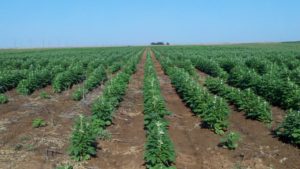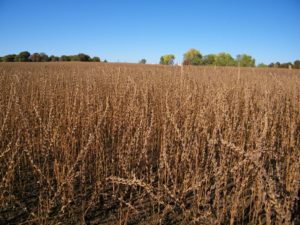by Dr. Calvin Trostle, Extension Agronomy, TAMU Dept. of Soil & Crop Sciences, Lubbock, 806-746-6101, ctrostle@ag.tamu.edu
Sesame is a heat-tolerant, drought-tolerant crop that has a good fit in much of Texas’ drier regions. It is grown in the Rolling Plains, South Plains, Concho Valley, Texas Wintergarden, Coastal Bend, and Lower Rio Grande Valley. Limitations to the Norwest include cooler temperatures associated with elevation > 4,000’, and in North & Central Texas, as one approaches I-35 from the west the tendency for greater disease issues increase due to higher humidity and rainfall.
Due to its small seed size it may present a planting challenge for some farmers. The right planter plates/discs and proper settings alleviate this). Also, few registered herbicides exist for sesame. Labels include Sonalan, some grass herbicides for mid-season control, and Dual products via an indemnified label (farmers take the risk of injury). Thus, sesame is not for your weedy ground.
Sesame has crop rotation advantages, wild hogs largely seem to leave it alone, it is suppressive of root knot nematode, and there are at least 17 Texas counties where program crop insurance is available. These counties include:
- High Plains: Gaines, Dawson, Terry, Hockley, Lubbock, Crosby, Lamb, Hale, Floyd, Castro, Swisher
- Rolling Plains: Childress(?), Hardeman, Haskell, Jones, Wilbarger, Wichita
- I am currently unaware of any county program crop insurance coverage in South Texas.
- Several southwest Oklahoma counties as well.
AgriLife Extension has prepared a summary of sesame production practices, primarily for the Texas Rolling & High Plains, posted online at http://lubbock.tamu.edu/sesame/ Brief information is also included for South Texas. Contractor information and contacts (Sesaco, http://www.sesaco.com, recent pricing $0.35/lb, irrigated or dryland), and basic agronomic practices are discussed, and links are provided to further contractor production and harvest resources. Last recommended planting dates extend to late June in the High Plains and early July in the Rolling Plains though earlier planting there appears advantageous. In case you heard, there is a second contractor/processor entering the Texas sesame market in 2018, but they do not anticipate publicly advertising contracts in 2018 but will instead focus on their existing growers in this start-up year.
Sesaco indicates that up to 100,000 acres are available for contracting. New for 2018 Sesaco has announced that all sesame in Texas can now use a harvest aid (glyphosate) as the standards on glyphosate tolerances in key export markets, particularly Japan, have been relaxed.

Fig. 1. Early August sesame in the northern Rolling Plains is flowering after a planting in late June. (Courtesy Whitney Bell)

Fig. 2. Dry sesame ready for harvest in late October, northern Rolling Plains. (Courtesy Whitney Bell)

Calvin Trostle
Professor and Extension Specialist
Lubbock, TX
803.746.6101
ctrostle@ag.tamu.edu